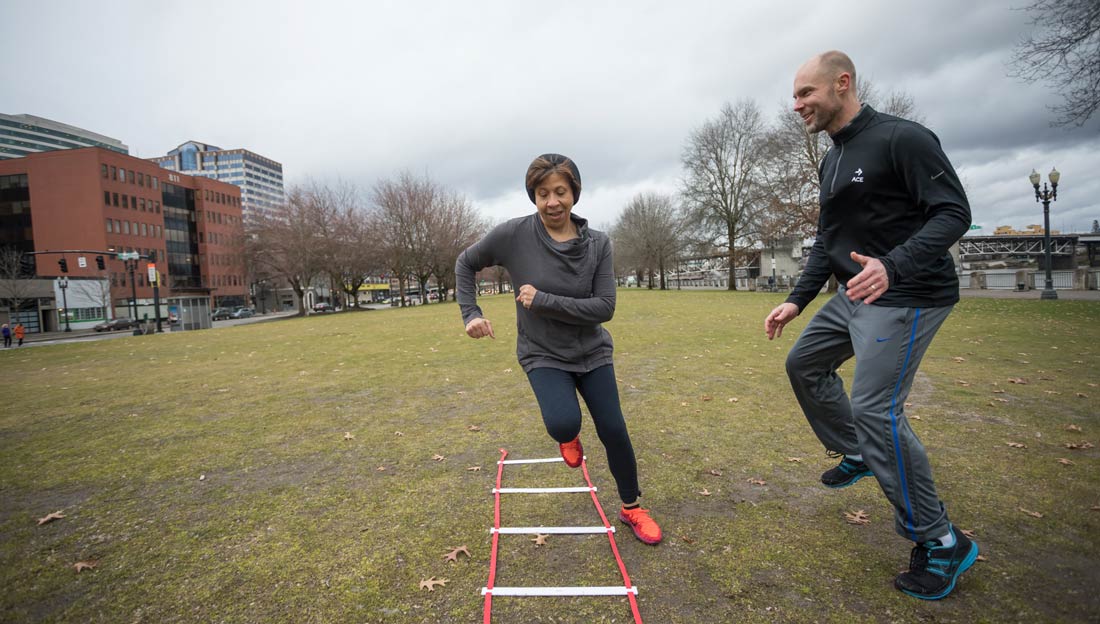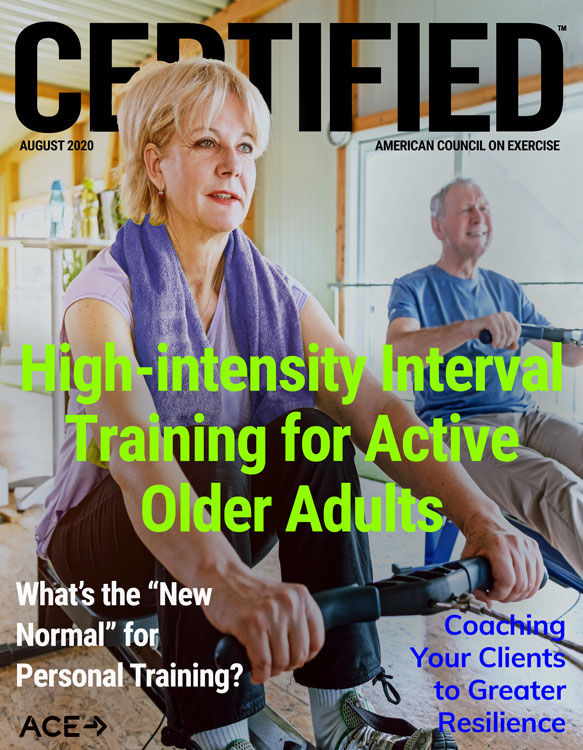
In this series, ACE experts answer your health and exercise questions. From high-intensity interval training to youth fitness, you’ll find detailed answers to many of the questions that may come up in your work with clients. If you have questions you’d like to ask our experts, please email us at Christine.Ekeroth@acefitness.org.
The Expert:
 Lance C. Dalleck, PhD, is an associate professor of Exercise and Sport Science at Western State Colorado University. His research interests include improving exercise performance and health outcomes through evidence-based practice, quantifying the energy expenditure of outdoor and non-traditional types of physical activity, and studying historical perspectives in health, fitness and exercise physiology. Dr. Dalleck is a member of the ACE Scientific Advisory Panel.
Lance C. Dalleck, PhD, is an associate professor of Exercise and Sport Science at Western State Colorado University. His research interests include improving exercise performance and health outcomes through evidence-based practice, quantifying the energy expenditure of outdoor and non-traditional types of physical activity, and studying historical perspectives in health, fitness and exercise physiology. Dr. Dalleck is a member of the ACE Scientific Advisory Panel.
Q: It’s often been said that it takes 21 days to form a new habit, but I recently heard that isn’t true. What does the research say about how long it really takes to form a habit?
Good question! First, let’s dispel the 21-day myth and then we can dive into what current research has to say about how long it takes to form a habit.
A myth can be defined as an untrue explanation for a natural phenomenon. Unfortunately, numerous myths remain pervasive and deeply engrained in the health and fitness world. The belief that it takes 21 days to form a new habit originated back in the 1950 and 1960s and was based upon various observations made by a cosmetic surgeon named Dr. Maxwell Maltz. After performing a procedure, Dr. Maltz noticed it took his patients about 21 days to get used to their new facial features. He also observed in his own life that it usually took about 21 days to form a new habit. These various observations were subsequently published by Dr. Maltz in his book, Psycho-Cybernetics. In the ensuing decades, what was once lore became truth and people accepted the idea that 21 days was the new habit-forming timeline, despite the fact that these were simply observations made by Dr. Maltz and not based upon formal scientific inquiry.
Over the past decade, however, robust research findings have provided us with a more scientifically driven answer to how long it really takes to form a new habit. In 2010, a group of health psychology researchers studied a cohort of 96 participants who chose an eating, drinking or activity behavior to carry out daily. The investigators sought to better understand the process, timeline and variability of habit formation. Here are the key findings from that study, which you can apply when working with your clients:
- The median number of days it took to form a habit was 66 days (far longer than the 21-day myth!).
- There was considerable individual variability in the timeline to form a new habit, with the number of days required ranging from 18 to 254. Interestingly, these individual differences in forming new habits parallel the individual variability in training responsiveness that I wrote about in an earlier article.
- Missing occasional opportunities to perform a given behavior (i.e., eating fruit with lunch) did not impede the habit-formation process. This is an important point because it means one does not necessarily need to remain perfect when trying to form a healthy habit.
- Different habits required different timelines. For example, exercise habits took one-and-a-half times longer to develop compared to nutritional (i.e., eating or drinking) habits.
Another more recent study, which focused on new gym members for 12 weeks, offers some additional insight into how long it takes to form a habit. The key takeaways of this study include:
- The minimum threshold for establishing a regular exercise habit was exercising at least four times per week for six weeks.
- Health and exercise professionals should focus on keeping exercises fun and simple for new clients. Combined with consistency, this approach was likely to lead to new habit formation in six weeks.
While research can give us an idea of how long it takes to form a habit, it’s important to remember that no single one-size-fits-all approach will work for everyone. Take the time to reassure your clients that different habits require different timelines and those timelines will vary depending on their own unique characteristics and circumstances.
2) I have found that clients who try to make too many changes at once usually don’t succeed. Improving diet, increasing exercise, reducing stress—what types of changes should people focus on first?
Much like habit formation, there is no one-size-fits-all answer to this question. Fortunately, ACE Certified Professionals now have an excellent resource and behavior-change guide that you can use with your clients: the ACE Mover Method. The ACE Mover Method is a philosophy and approach built around the belief that facilitating healthy lifestyle behaviors begins with empowering clients to take a personalized journey during which they achieve self-efficacy because you—the exercise professional or health coach—practice empathy and trust, communication and collaboration. Through actionable steps, the ACE Mover Method offers you a way to help get people moving toward a better quality of life.
Another tool that can be used with the ACE Mover Method to help a client know which habits to focus on first involves the use of scaling questions to assess importance and confidence, which Dr. Natalie Muth wrote about in an earlier issue of this publication. First described by Bill Miller and Stephen Rollnick, the founders of motivational interviewing, the importance ruler offers a quick way to get a sense of a client’s readiness to change, while also presenting an opportunity to spark “change talk” (the phrase Miller and Rollnick use to describe a client voicing reasons to change). Here’s how it works:
First, ask a client on a scale of 1 to 10, 1 being not at all important and 10 being essential, how important is it to make a change. Alternatively, you could offer a piece of paper that looks like this and ask the client to mark the spot:

When your client offers a number, let’s say a 5, ask the client, “Why a 5 and not a 3?” By asking this question, you prompt the client to talk their way up the ruler by explaining why changing might be important—perhaps to prevent a disease, improve health, make activities of daily living easier, etc. If you were to ask the client the question in reverse—“Why a 5 and not an 7?”—you would prompt the client to talk their way down the ruler by explaining why changing is not that important. Miller and Rollnick call this “sustain talk,” or the voicing of reasons not to change. All that does is help a client more firmly commit to not changing.
After your client describes some reasons why the change is moderately important, ask: “What would it take to get from a [5] to a [7]?” Now, you have prompted the client to come up with some potential solutions.
Repeat this process with the next question:
“On that same 1 to 10 scale, how confident are you that you can make this change?”

The answer to this question reveals a client’s degree of self-efficacy. Through your prompts (as in the first question), you can help a client make a case for why they can do it, as well as ways to possibly increase self-efficacy.
By the end, you’ve helped your client move a little closer to changing while also getting a good sense of where they stand currently on their behavior-change journey. This will help your clients identify which areas they should focus on first, and then collaborate with you on an individualized behavior-change plan.
Note: Using the button at the top of this page, ACE Certified Professionals can access an exclusive PDF that describes how to apply the ACE Mover Method to prioritize lifestyle changes. Also included is a guide to agenda mapping, excerpted from The Professional’s Guide to Health and Wellness Coaching.
3) What advice can I give to a client who is trying to make healthy lifestyle changes, but feels unsupported by their partner or children?
One of the biggest mistakes I see clients make is not effectively communicating their healthy lifestyle goals with their partners and family members. For instance, I had a client who wanted to start eating more vegetables. Not long after we started working together, she came to me on a Friday morning for her exercise session feeling dejected. After I asked her what was wrong, she shared that her family did not approve of her nutritional goals and they all wondered why they were suddenly eating salad every night of the week. I asked if she had explicitly shared her dietary objectives with her family, but she said she hadn’t yet done so. I urged her to have this important family conversation before proceeding further.
When it comes to making healthy lifestyle changes, it’s also important for clients to discuss expectations with their families. For example, a client might want to become physically active, yet, because of their partner’s job demands, they bear the sole responsibility of getting their three children to and from school every day. While it may not be realistic for the client to expect their partner to start exercising with them every day, it may be reasonable to expect they would start to share some of the before- or after-school responsibilities to make it possible for your client to carve out time to complete their workout routine.
It’s also important to help clients honestly identify a realistic level of support. My experience suggests that clients are frequently expecting more support than their partner can realistically offer. In these scenarios, it can be helpful for the client to identify alternative sources of support, such as that found in group fitness classes or exercise programs. Research has shown that social influences prompt behavior change as individuals make an effort to match up to a social environment or “fit in.” Accordingly, if you can facilitate client engagement in personalized group exercise programs, this may expose them to powerful social influence norms.
Lastly, it’s worth looking at the use of wearable technologies as a source of support and motivation. Unfortunately, improvements in technology have made it a lot easier to live a sedentary lifestyle. In fact, technological advancements in the Digital Age (the last two generations) have almost completely eliminated the physical activities once required by daily life. The systematic transition from a physically active lifestyle in our natural outdoor environment to a sedentary, indoor lifestyle is at the root of many prevalent chronic diseases such as diabetes and heart disease. The answer? One approach is to use technology itself to increase physical activity and form other positive lifestyle habits. Indeed, research has shown that wearable technologies can be used to increase self-monitoring and motivation for increased physical activity.
One final thought: Don’t think of wearable technologies such as watches or smartphone applications as a possible replacement of the expertise you offer to your clients. On the contrary, wearable technologies hold enormous potential to support the delivery of your expertise and services.





 by
by 

 Lance C. Dalleck, PhD, is an associate professor of Exercise and Sport Science at Western State Colorado University. His research interests include improving exercise performance and health outcomes through evidence-based practice, quantifying the energy expenditure of outdoor and non-traditional types of physical activity, and studying historical perspectives in health, fitness and exercise physiology. Dr. Dalleck is a member of the ACE Scientific Advisory Panel.
Lance C. Dalleck, PhD, is an associate professor of Exercise and Sport Science at Western State Colorado University. His research interests include improving exercise performance and health outcomes through evidence-based practice, quantifying the energy expenditure of outdoor and non-traditional types of physical activity, and studying historical perspectives in health, fitness and exercise physiology. Dr. Dalleck is a member of the ACE Scientific Advisory Panel. 
